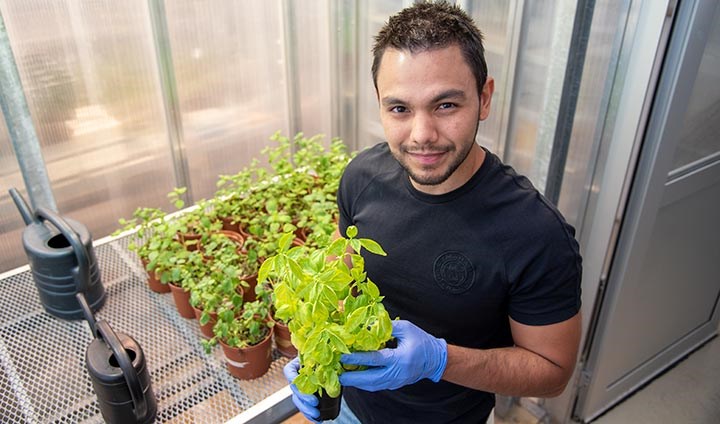Dill grown in greenhouses with UV light better tasting

Victor Castro-Alves has also done experiments on basil.
Örebro researchers added UV light in the greenhouse to impact the flavour in dill – and it paid off.
To understand why the dill tastes better, researchers have examined what happens inside the dill. The next step is to grow dill that not only tastes better, but that is also healthier.
Read the scientific article in Food Chemistry
“We want it to taste more like dill grown outdoors – to taste less like grass and have a stronger, more bitter, zesty dill flavour. For this, more amino acids and organic acids are required, as well as less saccharides,” says Victor Castro-Alves, chemistry researcher within Örebro University’s initiative on Food and health.
Using greenhouses has many advantages. Year-round cultivation is possible, and they protect against various infestations and diseases. The drawback is that greenhouses block out UV rays – which has an adverse effect on flavour.
Researchers have opted to use dill as it is often grown in greenhouses in Sweden, but the research can be applied also to other plants. They have added as much UV light as there would be outside on a sunny day.
Protect itself against the light
“If we add too much light, the dill starts to produce substances to protect itself against the light, which may affect how much the plants grow. So we have to strike the right balance,” says Victor Castro-Alves.
For the study, he compared dill growing in a controlled environment with the right amount of UV light to dill:
· from supermarkets,
· grown at the university using the same methods as in commercial dill cultivation, and
· from a supplier growing their dill indoors and outdoors.
The researchers did the experiment twice – over two consecutive years.
In a blind taste test, a panel from the School of Hospitality, Culinary Arts and Meal Science sampled the dill. The first year, there were 30 trained taste testers on the panel, the second year there were 20.
The outdoor dill had superior flavour
According to the panel, the dill from the supermarket and the dill grown by researchers in greenhouses without UV light had comparable flavour. The outdoor dill had superior flavour.
“The dill grown outdoors had a zesty, bitter and slightly sharp dill flavour. The commercially grown greenhouse dill had a sweeter flavour with notes of grass or green but lacked the characteristic dill flavour.”
“The dill grown with UV light scored between these two. It has the dill flavour, although not as distinctly as in the dill grown outdoors. It also has some of the sweet, green flavour found in the commercially grown greenhouse dill.”
Victor Castro-Alves is pleased with the result as it proves that the flavour in greenhouse-grown herbs and vegetables can be improved by changing the light conditions.
“These are good results. Getting the lighting just right is difficult. But if we know what it is that changes within the dill as we alter the lighting, then we can produce new variants that have these very characteristics and are therefore better tasting.”
What happens inside the plant
In order to study what happens inside the plant, researchers are using an approach referred to as metabolomics.
“We focused on substances that the plant produces more of and that affect the flavour, notably different saccharides, amino acids, organic acids and phenolic acids. We also looked at two compounds that have previously been identified as particularly significant for dill flavour: phellandrene and dill ether.”
“Our studies show that using these two was not sufficient as markers for dill flavour, but a broader spectrum is needed.”
By comparing the chemical analyses with the sensory analysis – in other words the taste sensation – researchers found that amino acids and organic acids were strongly associated with the bitter, zesty and sharp dill flavour. A low level of saccharides was also favourable. When dill has notes of grass, it is because essential flavour components are missing.
“By altering the level of various substances in the plant, you can create a better product. This can be done in other ways than with just UV light. We can adapt the plant using other technology – and design plants that produce the right levels of a variety of substances.”
This is possible by combining knowledge from a number of research fields and the two approaches metabolomics and sensory analysis.
“The next step is to include the health perspective. The goal is to find simple ways of growing herbs and vegetables, which not only taste good but are also healthier. These two go together – if it doesn’t taste nice it doesn’t matter if it’s healthy. We won’t eat it,” concludes Victor Castro-Alves.
Text: Linda Harradine
Translation: Charlotta Hambre-Knight
Photo: Jesper Mattsson
